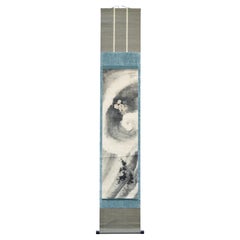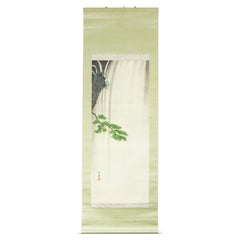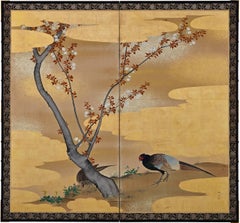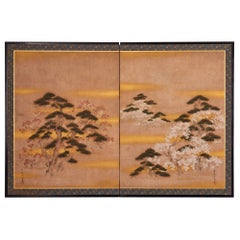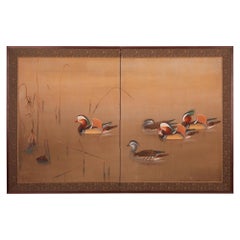Japanese Paintings and Screens
6
808
50
to
44
508
194
858
844
845
13
9
2
119
326
363
50
170
91
14
24
4
16
12
2
7
6
3
1
482
457
421
295
286
1,530
1,369
858
455
84
3
3
2
1
1
Place of Origin: Japanese
Japanese Meiji Period Painting Scroll Water Spirit Japan Artist Signed
Located in Amsterdam, Noord Holland
Japanse school Watergeest
Rolschildering / scroll op papier, lakwerk rollers. B- 112 x 31.2 / 194 x 35.3 cm
112 x 31.2 / 194 x 35.3 cm
Category
Mid-19th Century Meiji Antique Japanese Paintings and Screens
Materials
Silk
Japanese Meiji Period Painting Scroll Landscape Nihonga Japan Artist Signed
Located in Amsterdam, Noord Holland
Japanse school Esdoorntak voor waterval
Rolschildering / scroll op zijde, benen rollers. B 106 x 42.8 / 167 x 56.1 cm
106 x 42.8 / 167 x 56.1 cm
Category
Mid-19th Century Meiji Antique Japanese Paintings and Screens
Materials
Silk
Antique Japanese Brass Painting 'Romantic Serenade'
Located in Milano, IT
Ancient and very rare Japanese painting made in the early 1900s of fine Japanese manufacture. The painting has a rectangular brass frame, with rounded corners. Internally we see an a...
Category
Early 1900s Anglo-Japanese Antique Japanese Paintings and Screens
Materials
Brass
Early 19th Century Japanese Screen. Cherry Blossom & Pheasants by Mori Tetsuzan
Located in Kyoto, JP
Mori Tetsuzan (1775-1841)
Pheasants and Cherry Blossoms
Two-fold Japanese screen. Ink, color, gofun, gold and silver on paper.
A two-fold Japanese bir...
Category
Early 19th Century Edo Antique Japanese Paintings and Screens
Materials
Gold Leaf
Japanese Two-Panel Screen, Pine, Cherry, and Maple
Located in Hudson, NY
Cherry blossoms and maples among ragged pines. Mineral pigments on mulberry paper with gold mist clouds. Completely remounted utilizing an antique silk brocade...
Category
Mid-19th Century Antique Japanese Paintings and Screens
Materials
Gold, Bronze
Japanese Two Panel Screen: Mandarin Ducks Among Dry Lotus
Located in Hudson, NY
Natural scene of Mandarin ducks gliding gracefully amongst the water.
Mineral pigments on silk with silk brocade border and natural wood trim. Seal reads: Kei.
Category
Early 20th Century Japanese Paintings and Screens
Materials
Silk, Wood
Japanese Two-Panel Screen, Wading Deer
Located in Hudson, NY
In Japan, it is a Shinto belief that the deer is a treasured and sacred animal. This admirable scene captures this gentle creature in its natural habitat with beautiful detail in bot...
Category
Early 20th Century Japanese Paintings and Screens
Materials
Silk, Lacquer
Japanese Meiji Period Painting Scroll Landscape Masuda Amison 1886 in Osaka
Located in Amsterdam, Noord Holland
Masuda Amison
(1886- ? ) Japanese painter. Commonly known as Wasaburo
Born in 1886 in Osaka.
He lives in Koroen, Nishinomiya City, Hyogo Prefecture....
Category
Early 20th Century Meiji Japanese Paintings and Screens
Materials
Silk
Meiji Period Japanese Screen Pair, One Hundred Birds by Hasegawa Gyokujun
Located in Kyoto, JP
One hundred birds
Hasegawa Gyokujun (1863-1921)
Meiji period, circa 1900.
Ink, color and gofun on silk.
Dimensions of each screen:
H. 170 cm x W. 190 cm (67’’ x 75”)
Despite the title, well over 100 birds are represented in this pair of two-fold Japanese screens (the title functions figuratively to convey the idea of a large number). The monumental work is rendered with a comprehensive and highly complex composition which is exquisitely executed and meticulously colored. More a celebration of naturalism than the traditional “One Hundred Birds” paintings which originated in China. This was a subject matter known for its auspicious meaning as much as its actual depiction of nature. These paintings generally had a phoenix (occasionally peacocks) placed in the center, and the other birds paying homage to it.
In this quintessentially Japanese scene painted by Gyokujun, a couple of long-tailed birds modeled after paradise flycatchers are included; these are traditional auspicious motifs in Oriental bird and flower painting and denote themes such as celebration and enduring generations. In addition there is the playful inclusion of single exotic parrot. Even so, the vast majority of the birds and flowers are native to Japan. Reading the scene from right to left, from spring through to autumn, the overwhelming sense is one of movement and haste. It is almost as if the birds are in a race, with the fleetest leading the way forward. Although these native birds were commonly drawn amongst artists of the Shijo school, rarely were they painted with such drama and dynamism. It is not strictly a depiction of sketched birds whose manner was faithfully handed down through the traditions of the Shijo school. Rather we see Gyokujun seeking and achieving new expressions in the heart of the turbulent Meiji period.
Hasegawa Gyokujun (1863-1921) was born in Kyoto. He was the eldest son of Hasegawa Gyokuho, a Shijo school painter who studied under Matsumura Keibun. Gyokujun studied painting under his father and became a prominent member of the Kyoto painti
ng world from a young age. In 1891 he established the ‘Young Painters Social Club’ along with Takeuchi Seiho, Miyake Gogyo and Taniguchi Kokyo. Also in 1891 he was selected as a judge of the Great Private Paintings Exhibition along with Takeuchi Seiho, Yamamoto Shunkyo...
Category
Early 1900s Meiji Antique Japanese Paintings and Screens
Materials
Silk, Wood
Japanese Six-Panel Screen Byobu With Chrysanthemums And Autumn Grass and Flower
Located in Torino, IT
The 19th Century Six-Panel Japanese folding screen "Byōbu" usually used in the most important Japanese house to stop wind and also to separate different space of the same big room de...
Category
Mid-19th Century Edo Antique Japanese Paintings and Screens
Materials
Gold Leaf
Ôhara Donshû (1792 - 1857) Edo Period - Smell of Plums in the Night. Scroll
Located in Amsterdam, Noord Holland
Ôhara Donshû (1792 - 1857) De geur van pruimen in de nacht
Rolschildering / scroll op zijde, houten rollers, in houten cassette. Provenance: Oranda Jin. A/B 98.8 x 29.4 / 184 x 41.5 ...
Category
Early 19th Century Meiji Antique Japanese Paintings and Screens
Materials
Silk
Japanese Edo Period Painting Scroll Ônishi Chinnen '1792 - 1851' Artist Signed
Located in Amsterdam, Noord Holland
Ônishi Chinnen (1792 - 1851) Schilpadden en bamboo
Rolschildering / scroll op papier, benen rollers. B 125.7 x 48.9 / 179.5 x 59.5 cm
125.7 x 48.9 / 179.5 x 59.5 cm.
Category
Mid-19th Century Meiji Antique Japanese Paintings and Screens
Materials
Silk
Japanese Two-Panel Screen: Cranes on Gold
Located in Hudson, NY
Early Kano School painting of pine trees overlooking two beautifully painted cranes and floral design in a natural setting by water’s edge. Mineral pig...
Category
Late 18th Century Antique Japanese Paintings and Screens
Materials
Gold, Gold Leaf
Japanese Two Panel Screen: Horses in Stable
Located in Hudson, NY
A pair of captivating black and white horses, believed to define hard work and power in Japanese mythology, are beautifully rendered in this painting of mineral pigments on mulberry ...
Category
Early 19th Century Antique Japanese Paintings and Screens
Materials
Bronze, Gold Leaf
19th Century Japanese Screen for Tea-Ceremony, Ink Bamboo and Plum on Gold Leaf
Located in Kyoto, JP
Three Friends of Winter
Nakajima Raisho (1796-1871)
Late Edo period, circa 1850
Ink and gold leaf on paper.
This is a double-sided Japanese Furosaki or tea-ceremony screen from the mid 19th century; bamboo and plum on the front, young pines the back. It by Nakajima Raisho, a master painter of the Maruyama school in the late Edo and early Meiji periods. In this work Raisho combines exquisite ink brushwork with large open spaces of brilliant gold-leaf to inspire the viewers imagination. Rather than naturalism, he is searching for the phycological impression of the motifs, resulting in abstraction and stylization. His simplification of the motifs the result of looking to capture the inner nature of the objects. This art motif is known as Sho Chiku Bai, or the Three Friends of Winter. Evergreen pine connotes steadfastness, bamboo suggests both strength and flexibility, while plum blossoms unfurling on snow-laden branches imply hardiness. Combined, this trio is emblematic of Japanese new year. Chinese literati were the first to group the three plants together due to their noble characteristics. Like these resilient plants flowering so beautifully in winter, it was expected of the scholar-gentleman to cultivate a strong character with which he would be able to show the same degree of perseverance and steadfastness even during times of adverse conditions.
The screen would have been placed near the hearth of a room used for the Japanese tea ceremony, shielding the fire from draughts and also forming a stimulating and decorative backdrop behind the tea utensils. It would have been used in the Hatsugama, or first tea-ceremony of the new year.
Nakajima Raisho (1796-1871) originally studied under Watanabe Nangaku before entering the school of Maruyama Ozui. He was the highest ranking Maruyama school painter at the end of the Edo period and was known as one of the ‘Four Heian Families’ along with Kishi...
Category
Mid-19th Century Edo Antique Japanese Paintings and Screens
Materials
Gold Leaf
Japanese Meiji Period Woodblock Kono Naotoyo Bairei '1844 - 1895' Artist Signed
Located in Amsterdam, Noord Holland
Kono Naotoyo Bairei (1844 - 1895) Bairei Hyakucho Gafu
11 houtsneden van vogels - drie met elk twee stukjes tape op papier geplakt. B ca. 20.5 x 14.5 cm pst. / alle niet ingelijst
...
Category
Mid-19th Century Meiji Antique Japanese Paintings and Screens
Materials
Silk
Ancient Japanese Painting Framed in Brass 'Traditional Dance'
Located in Milano, IT
Ancient and very rare Japanese painting made in the early 1900s, fine Japanese manufacture.
The painting has a rectangular brass frame, with rounded corners. Internally we see a further frame in yuta, classic sand colour, very nice. Yet another very small brass frame that frames the picture. The painting is a print painted on black cardboard, with whimsical and strong colors, typical of Japanese art.
This represents a scene with a man and a woman, intent on dancing, arm in arm and spinning in a typical traditional Japanese dance...
Category
Early 1900s Anglo-Japanese Antique Japanese Paintings and Screens
Materials
Brass
Japanese Two Panel Screen: Flowering Vines and Wisteria
Located in Hudson, NY
Wisteria represents sentiments of love and longevity as vibrant floral colors dance dramatically amongst the two panels. Mineral pigments on Mulberry paper with a natural wood trim....
Category
Early 20th Century Japanese Paintings and Screens
Materials
Wood, Paper
Japanese Painting Scroll Crane Landscape Nihonga Japan Artist Sign
Located in Amsterdam, Noord Holland
Japanse school Vrouw op brug
Rolschildering / scroll op zijde, benen rollers. B 77.5 x 36.9 / 160 x 49 cm
77.5 x 36.9 / 160 x 49 cm.
Category
Mid-19th Century Meiji Antique Japanese Paintings and Screens
Materials
Silk
Japanese Six Panel Screen Scattered Fans
Located in Hudson, NY
Striking painting depicting scattered fans painted on gold leaf. Featuring various scenes from classic Japanese literature, flowers and birds. Mineral pigmen...
Category
Mid-18th Century Antique Japanese Paintings and Screens
Materials
Gold Leaf
Japanese Two Panel Screen: White Tiger Grotto
Located in Hudson, NY
A mysterious passageway with natural rocky detail as the scene drifts deep into the darkness.
Dyed fabric mounted with a natural wood trim. Signed on back and lower right corner. Sig...
Category
Early 20th Century Japanese Paintings and Screens
Materials
Fabric, Wood
Japanese Six Panel Screen: Plain Silver Leaf on Paper
Located in Hudson, NY
(no image) With beautiful oxblood color lacquer frame with 19th century bronze mounts.
Category
Early 20th Century Japanese Paintings and Screens
Materials
Bronze, Silver Leaf
Nightingale on Branch Meiji Period Scroll Japan 19/20c
Located in Amsterdam, Noord Holland
Very Lovely painting.
Category
Mid-19th Century Meiji Antique Japanese Paintings and Screens
Materials
Silk
Japanese Meiji Period Painting by Shôjin Nishimura , Plum tree in Moonlight
Located in Amsterdam, Noord Holland
Very Lovely painting.
Category
Mid-19th Century Meiji Antique Japanese Paintings and Screens
Materials
Silk
Scroll Kitsuda Eihô (1902 - 1974) Breaking of Dawn in the Mountains Japanese
Located in Amsterdam, Noord Holland
Kitsuda Eihô (1902 - 1974) Aanbreken van de dag in de bergen
Rolschildering / scroll op zijde, houten rollers, in houten cassette. Herkomst: Oranda Jin. B 128 x 41.9 / 202 x 56.3 cm...
Category
Mid-20th Century Meiji Japanese Paintings and Screens
Materials
Silk
'Two Dutch Ships Anchored in the Bay of Nagasaki' by Kawahara Keiga '1786-1860'
Located in Amsterdam, NL
Kawahara Keiga (1786 - c. 1860)
Two Dutch ships anchored in the bay of Nagasaki
Sumi ink and pigment on silk, H. 27 x W. 41 cm (excl. frame)
Comes framed, see image.
?Based o...
Category
Early 19th Century Antique Japanese Paintings and Screens
Materials
Silk
260 Year Old Japanese Hanging Scroll with Painting of the 9-Headed Dragon Deity
Located in Amsterdam, NL
Amazing 260 year old Japanese kakejiku (hanging scroll) with a refined painting of the nine headed dragon deity, with a Buddhist flame as a crown, an...
Category
Mid-18th Century Antique Japanese Paintings and Screens
Materials
Metal
Antique Double Sided Japanese Ranma Transom Panels - a Pair
Located in Morristown, NJ
19th/20th c., Antique hand-carved Japanese ramna panels depicting landscapes of black pine trees, temples, mountains and clouds. Likely carved from yaku cedar in the Osaka tradition of chokokuranma (carved transom), these are double sided three-dimensional landscape designs. The design is mirrored on each side of the panel.
Ranma panels...
Category
Late 19th Century Meiji Antique Japanese Paintings and Screens
Materials
Wood, Cedar
Antique Framed Japanese Shunga Woodblock Print of a Couple Making Love
Located in Yonkers, NY
An antique Japanese Shunga woodblock print in gilt frame depicting a man and a woman making love. Created in Japan, this woodblock print called...
Category
19th Century Antique Japanese Paintings and Screens
Materials
Glass, Wood, Paint
19th Century Japanese Scroll Painting by Igarashi Chikusa, Poppies & Butterflies
Located in Kyoto, JP
Poppies & Butterflies
Ink, pigment and gofun on silk
Igarashi Chikusa (1774-1844)
Signature: Chikusa Ran Zen
Upper Seal: Ran Shuzen
Lower Seal: Kyoho
Dimensions:
Scroll: H. 68” x W. 18” (172cm x 45cm)
Image: H. 38.5’’ x W. 12.5’’ (98cm x 32cm)
This composition shows elegant images of poppies and the butterflies that are inevitably drawn to them. It captures a momentary glimpse into a world both visually dazzling and startlingly realistic. The painting is infused with sensitivity and attention to seasonal change and weather conditions. The thin and fragile poppies are beautifully depicted with brilliant colors and the butterflies are similarly infused with life. The painting is on silk which requires extremely precise painting skills as no element once painted can be removed.
Poppies were a favorite subject of Rinpa school artists through the ages. Originally they were somewhat abstracted but by the age of Sakai Hoitsu...
Category
Early 19th Century Edo Antique Japanese Paintings and Screens
Materials
Silk
Pair Large Framed Japanese Calligraphy "Dragon" & "Tiger", Mid 20th Century
Located in Austin, TX
A large and powerful pair of Japanese calligraphic works, mid 20th century, Japan. One reading "Dragon", the other reading "Tiger". Ink on handmade paper, framed.
The brush strok...
Category
Mid-20th Century Expressionist Japanese Paintings and Screens
Materials
Paper
17th Century Japanese Screen Pair, Cranes
Located in Kyoto, JP
Cranes
Anonymous, Kano School.
Edo period, second half of the 17th century.
Pair of six-panel screens. Ink, pigment gofun and gold l...
Category
1670s Edo Antique Japanese Paintings and Screens
Materials
Gold Leaf
Japanese Two Panel Screen: Summer Flowers
Located in Hudson, NY
Screen depicts Summer flowers and birds on gilded silk. Signature reads: Konishi Fukunen. Notes about Artist: Konishi Fukunen (1887-1959) was born the second son of the Paper mounting specialist Konishi Uhei in Takeo, Fukui prefecture in the mid Meiji period. In 1902 he was sent to Kyoto to study painting under Suzuki Shonen...
Category
Mid-20th Century Japanese Paintings and Screens
Materials
Silk
Japanese Six Panel Screen: Tosa School Painting of Theatre Scene
Located in Hudson, NY
with thought to be Izumo no Okuni (1578-1613). Mineral pigments and gold dust on mulberry paper with silk brocade border.
Category
18th Century Antique Japanese Paintings and Screens
Materials
Gold
Japanese Six Panel Screen, Peonies and Young Growth on Gold Silk
Located in Hudson, NY
Rimpa floral scene. Pigment on gilded silk, signature and seal read: Hattori Shunyo. Bold colors and strong design elements combined with the trademark tarashikomi (diluted elements created when water is applied to the surface before or after pigments causing them to diffuse) exhibit the artists deep devotion to this important Japanese painting tradition. Notes about artist: Hattori Shunyo (b. 1883) was an artist from Kyoto who graduated the (now) Kyoto Municipal University of Art and fell under the circle of Yamamoto Shunkyo...
Category
Early 20th Century Japanese Paintings and Screens
Materials
Brocade, Silk
Japanese Six Panel Screen: Red Maple and Flowers on Gold Silk
Located in Hudson, NY
Rimpa Floral Scene with Chrysanthemum, Morning Glories and Blue Bell Flowers. Pigment on gilded silk, signature and seal read: Hattori Shunyo. Bold colors and strong design elements combined with the trademark tarashikomi (diluted elements created when water is applied to the surface before or after pigments causing them to diffuse) exhibit the artists deep devotion to this important Japanese painting tradition. Notes about artist: Hattori Shunyo (b. 1883) was an artist from Kyoto who graduated the (now) Kyoto Municipal University of Art and fell under the circle of Yamamoto Shunkyo...
Category
Early 20th Century Japanese Paintings and Screens
Materials
Brocade, Silk
Unpei Kameyama, 'a View of Black 'American' Ships in the Bay of Uraga Senminato'
Located in Amsterdam, NL
Unpei Kameyama (1821-1899)
A view of black (American) ships in the bay of Uraga Senminato, Miura district, June 1853
The Japanese text reads: ‘The seventy-six old men for the Kitamura-clan, drawn in 1897 on request of Yoshisada Kitamura, Himeji, the black ships which so much changed the fate of Japan, enjoy please this masterpiece by Harima Shonin Bisei who brings back memories of his young days.’
Watercolour on paper, laid down on cardboard, H. 44.5 x W. 115.5 cm
Provenance:
Collection of Yoshisada Kitamura, Himeji
Yoshisada Kitamura (1838-1899), the son of a farmer in the village of Ogawa, in the district of Harimakashikihigashi, studied under Matajiro Otaka and got heavily involved in the anti-Shogunate movement. He was active in several military incidents against the Shogunate. After the Meiji restoration, he served the Meiji government as a local official in the Himeji domain.
Kameyama Unpei was a Confucian scholar, a Shinto priest...
Category
Mid-19th Century Edo Antique Japanese Paintings and Screens
Materials
Paper
Japanese Two Panel Screen: Sun over Cresting Waves with Golden Clouds
Located in Hudson, NY
Sun rising over cresting waves through tropical trees. Mineral pigments on mulberry paper with gold dust and brocade.
Category
Early 20th Century Japanese Paintings and Screens
Materials
Gold
Japanese Showa Painted Panels on Silk Horses & Deer by Carlota T. Ige
Located in Rio Vista, CA
Dreamy Japanese Showa period Nihonga school influence set of four painted panels depicting a lovely serene landscape. Natural ink and color pigments are painted on silk. Highly detai...
Category
20th Century Showa Japanese Paintings and Screens
Materials
Metal
Japanese Four Panel Screen, Golden Sun Through Turbulent Surf
Located in Hudson, NY
Golden sun viewed through red maple above turbulent waves. Mineral pigments on gold and silver ground with silk brocade border.
Category
Mid-20th Century Japanese Paintings and Screens
Materials
Gold Leaf, Silver Leaf
Japanese Showa Six Panel Screen Manchurian Crane Bamboo Grove
Located in Rio Vista, CA
Enchanting Japanese Showa period six-panel byobu screen titled "Bamboo Forest-Immortal Together". The large screen depicts six manchurian cranes in a ...
Category
20th Century Showa Japanese Paintings and Screens
Materials
Brass
Japanese Six Panel Screen: Mountains in the Mist with Tree-Lined Foothills
Located in Hudson, NY
Verdant landscape of mountains and rolling foothills shrouded in mist. Mineral pigments on silk with gold dust. Raw silk backing.
Category
Early 20th Century Japanese Paintings and Screens
Materials
Gold
Japanese Six Panel Screen: Pheasants Beneath Flowering Cherry
Located in Hudson, NY
Mineral pigments on gold leaf. Signature and seal read: Baikei Hitsu.
Category
Late 19th Century Antique Japanese Paintings and Screens
Materials
Gold Leaf
Japanese Two Panel Screen: Simple Chrysanthemums on Gold
Located in Hudson, NY
Mineral pigments on gold leaf. Not signed, by: Baikei Hitsu.
Category
1880s Antique Japanese Paintings and Screens
Materials
Gold Leaf
Japanese screen with a painting of an large elephant & monkey by Mori Kanson 森間村
Located in Amsterdam, NL
A marvellous, tall six-panel byôbu (folding screen) with a rare painting of a large white elephant standing under a blooming paulownia tree (kiri), with a monkey sitting on the ear o...
Category
19th Century Antique Japanese Paintings and Screens
Materials
Metal
Japanese Four Panel Screen: Autumn Flowers and Moon on Gold
Located in Hudson, NY
Mineral pigments on gold leaf.
Category
Early 20th Century Japanese Paintings and Screens
Materials
Gold Leaf
Japanese Antique Ink Painting / 19th Century / Rare Chinese Character Painting
Located in Sammu-shi, Chiba
We have a unique Japanese aesthetic sense.
And only we can introduce unique items through our purchasing channels in Japan and the experience we have gained so far, in such a way that no one else can imitate.
It is an ink painting written after the Meiji era.
The biggest attraction of this work is that it uses Chinese characters to create paintings.
To explain in detail, it is written here in Chinese characters as "un-ryu" .
"Un" is a cloud and "ryu" is a dragon.
These are embodied and drawn by comparing them to the meaning of Chinese characters.
And the clouds depict the clouds hanging over the mountain, and the dragon depicts the climbing toward the mountain.
Humorous paintings...
Category
Late 19th Century Edo Antique Japanese Paintings and Screens
Materials
Acrylic, Paper
Japanese Six Panel Screen: Clouds of Golden Mist
Located in Hudson, NY
Mineral pigments and gold on mulberry paper. Signature reads: Bunrei-Ga.
Category
Early 20th Century Japanese Paintings and Screens
Materials
Gold
Japanese Asian Large Edo Six-Panel Folding Byobu Screen Landscape Monkeys Trees
Located in Studio City, CA
An absolutely gorgeous, wonderfully composed six-panel Japanese Byobu folding screen/room divider depicting a family of playful monkeys among the blooming trees and mountainous lands...
Category
Early 19th Century Edo Antique Japanese Paintings and Screens
Materials
Gold Leaf
Japanese Two Panel Screen: Recumbant Pheasant in Snow Laden Pine
Located in Hudson, NY
The harmony of pine, plumb and bamboo with a splash of camillias in mineral pigmants on silk with a brocade border and silk backing in a gloss black frame. Excellent condition.
Category
1880s Antique Japanese Paintings and Screens
Materials
Brocade, Silk
Japanese Screen of Spring on Gold Leaf
Located in Brescia, IT
It is a two-panel screen from the Taisho period, around 1920, beautifully painted in excellent detail.
The best of Rinpa's school painting: large empty space that highlights a pair of mandarin ducks in the middle of the pond.
On the right, flying birds give the painting a great lightness, under many multicolored flowers they celebrate spring.
All very proportionate and pleasant, the dimension really interesting.
Mineral pigments on gold leaf. It turns out Anonymous.
Lucio Morini.
Category
Early 20th Century Taisho Japanese Paintings and Screens
Materials
Gold Leaf
Japanese Four Panel Screen, Snowy Mountain Landscape
Located in Hudson, NY
Hinoki (Japanese red pine) and other deciduous trees in mineral pigments on mulberry paper. Signature reads: Yosui.
Category
Early 20th Century Japanese Paintings and Screens
Materials
Paper
Japanese Two Panel Screen: Sheep Resting under Grape Arbor
Located in Hudson, NY
Soft mineral pigments on silk with brocade border. Signature and seal read: Jyogyu
Category
Early 1900s Antique Japanese Paintings and Screens
Materials
Brocade, Silk
Japanese Two Panel Screen: Bamboo with Calligraphy Poem
Located in Hudson, NY
Moon and bamboo in ink on gold paper with red and black lacquered negoro frame. (Meiji period) Calligraphy reads: Beauty in ink painting with standing woods and branches, like in par...
Category
Early 1900s Antique Japanese Paintings and Screens
Materials
Paper
Japanese Contemporary Brocade Silk Handcrafted Framed Oshie Decorative Art
Located in Takarazuka, JP
Exquisite Japanese contemporary framed oshie wall decorative art piece, recreating a famous painting from Meiji period featuring a Japanese dancer holding a net with cherry blossom ...
Category
21st Century and Contemporary Meiji Japanese Paintings and Screens
Materials
Brocade, Silk
Japanese Two Panel Screen: Flowers by River's Edge
Located in Hudson, NY
Mineral pigments on gilded silk with gilded bronze hardware. Signature reads: Shunkan.
Category
1930s Vintage Japanese Paintings and Screens
Materials
Bronze
Japanese Silver Screen Pair, Meiji Period, Herons & Plovers, Shijo School
Located in Kyoto, JP
Heron & Plovers
Ink and silver leaf on paper
Maekawa Bunrei (1837-1917)
A pair of low six-panel Japanese screens by Maekawa Bunrei, a later master of the Kyoto based Shijo school of painting. On the right screen a solitary white heron stands motionless in a stream. On the left screen plovers play along a shoreline. The elegant forms are executed employing fluid, minimalistic ink brushstrokes. The soft brushstrokes and the sharp light of the silver leaf lend the scenes a sense of translucence. The sophisticated composition superbly exploits the long, horizontal pictorial surface of the pair of folding screens...
Category
Early 1900s Meiji Antique Japanese Paintings and Screens
Materials
Silver Leaf
Antique Japanese Meiji Period Silk Embroidered Screen Room Divider Byobu C.1900
Located in London, GB
Antique Japanese Meiji period silk embroidered screen /room divider Byobu C.1900 Kyoto, Japan.
Silk embroidered satin lacquer framed panels....
Category
Early 1900s Meiji Antique Japanese Paintings and Screens
Materials
Silk, Lacquer
Recently Viewed
View AllMore Ways To Browse
Asian Four Panel Screen
Painted Silk Scroll
Antique Chinese Painting Of Birds
Antique Painted Folding Screens
Mineral Pigments On Silk
Pagoda Landscape
Panel Hand Painted Folding Screen
Antique Wooden Screen
Asian Scroll Painting Silk
Birds By Asian Artist
Black Lacquer Asian Painting
Chinese Screen On Silk
19th Century Chinese School
19th Century Korean
Antique Chinese Painting On Silk
Pair Scroll Painting
19th Century Chinese Calligraphy
Chinese Painting Stone
